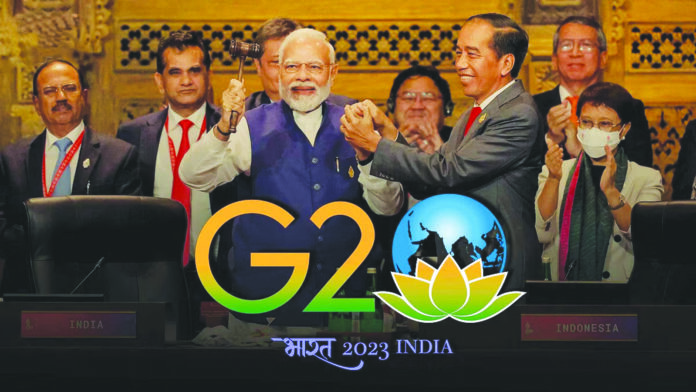As the curtains drew back on the G20 summit, India seized the global stage with an undeniable air of confidence. The spotlight was firmly trained on the South Asian nation, as it unveiled a series of ambitious economic corridors designed to reshape trade routes and boost economic ties with the western hemisphere. The newly launched India-Middle East-Europe Economic Corridor and the India-Europe Economic Corridor via West Asia have not only attracted substantial interest due to their vast scale but also for their potential to enrich global interconnectedness and prosperity. World leaders, including U.S. President Joe Biden, extended their appreciation for these initiatives, acknowledging them as “revolutionary investments” capable of propelling worldwide economic progress.
Interestingly, the nomenclature and ambit of these newly established economic corridors bears a striking resemblance to another notable initiative in the region – the China-Pakistan Economic Corridor (CPEC), a flagship project within the framework of the Chinese Belt and Road Initiative (BRI). Keen eyed observers have noticed this similarity, which adds an intriguing layer to the evolving dynamics in the region.
The Western world’s increasing attraction to India can be ascribed, in part, to the immense market opportunities it boasts and the strategic imperative of countering China’s influence. Whether India can fulfil these dual roles remains a matter of debate. However, what is clear is that India has garnered international approval as a brand in today’s interconnected world. India’s soft power is resonating on a broader scale, which translates into increased goodwill that it is trying to leverage for favourable commercial and strategic agreements, case in point the newly launched Middle Eastern and West African economic corridors.
The country left no stone unturned in its efforts to guarantee the success of the G20 event. The government spared no expenses in promoting the summit domestically, with billboards featuring PM Modi lining the streets of New Delhi. The city itself seemed to have undergone substantial preparations for the occasion.
Nevertheless, it is crucial to recognize that, while the government has made extensive efforts to project a flawless image, the real face of New Delhi has been concealed behind shrouds. The teeming slums of the city, occupied by the more abundant though less fortunate residents, had either been demolished or cordoned off by newly constructed barriers in anticipation of the summit. These actions underscore the striking juxtaposition between the glittering facade of the G20 and the socio-economic hardships faced by a significant portion of India’s populace.
Though local news channels covered the summit and its distinguished attendees extensively, it remains imperative to recognize that the success of such international events should not be gauged exclusively by their grandeur. The true measure of accomplishment lies in addressing the fundamental issues affecting the lives of all citizens, regardless of their proximity to the limelight.
It’s impossible to ignore the stark contrast between India’s display of economic strength and global aspirations at the G20, and the troubling human rights problems simmering within its boundaries. The continued subjugation of Kashmiri people since the abrogation of Article 370, atrocities against religious minorities, suppression of civil society, lack of free press/ media and the crumbling infrastructure of the capital are all concerns which the Indian leadership concealed nicely under real and metaphorical shrouds.
Worries encompassing the rights of minorities, especially the Muslim community, have echoed within and beyond the nation’s boundaries, portraying a grim tableau of the status of religious inclusivity and societal cohesion.
Furthermore, the disconcerting crackdown on voices of dissent, civil society groups, and independent journalism has cast a solemn shadow over India’s democratic credentials. The detention of activists and journalists during the G20 Summit stands as a vivid reminder of the hurdles facing both journalistic liberty and human rights within the country. A thriving democracy thrives on the unrestricted exchange of ideas and perspectives, yet India’s recent actions seem to contravene these fundamental tenets.
As India seems poised to take a more prominent role at the global stage, it is imperative to assess its readiness or indeed suitability for that role given the profound nature of domestic issues confronting the state. The international community also bears a responsibility in this regard. Global leaders must not shy away from addressing issues like Kashmir and minority rights during diplomatic engagements with India. President Biden, for example, chose to remain silent on the on-going atrocities against religious minorities in India throughout his visit and only addressed these concerns once he had left India and arrived in Vietnam. Multilateral forums, like the G20, offer a unique opportunity to discuss and advocate for meaningful change in areas that demand immediate attention.
It is crucial to remember that genuine global leadership extends beyond economic might and geopolitical strategies. It involves a steadfast dedication to upholding democratic principles, safeguarding human rights, and championing social equity, both on the world stage and within the confines of a nation’s territory.
India’s lofty global aspirations and its pursuit of becoming a prominent global player stand in stark contrast to the pressing domestic challenges that undermine its democratic principles and inclusive ethos. As the world watches, it falls upon us, collectively, to ensure that India is held accountable for its actions, unmasking the reality concealed beneath the veneer of glitz and glamour. The global commitment to democratic values, human rights, and social equity must transcend borders and guide the efforts towards a better future for all.























